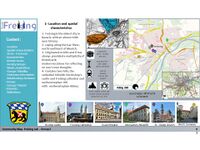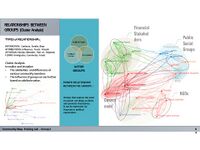LED2LEAP 2020 - Freising Team 2: Difference between revisions
| Line 264: | Line 264: | ||
File:Team2slide4assignment2.JPG |''Story 1'' | File:Team2slide4assignment2.JPG |''Story 1'' | ||
File:Team2Slide5Assignment2.JPG |''Story 2'' | File:Team2Slide5Assignment2.JPG |''Story 2'' | ||
File:Team2Slide06Assigment2.JPG |''Story 3'' | |||
File:Team2slide07Assignment2.JPG |''Story 4'' | |||
File:Team2Slide08Assignment2.jpeg |''Story 5'' | |||
</gallery> | </gallery> | ||
Revision as of 06:41, 3 June 2020
>>>back to working groups overview
Landscape Democracy Rationale
- Why do you think this community context is relevant from a landscape democracy perspective? What is your hypothesis considering the landscape democracy challenges?
We believe that we can solve the problems in question in order to Democratic landscape perspective in Freising.
It means that there is capacity to see the broad picture on Integrated actions at the landscape scale in Freising which allow groups to evolve dynamically.
ASSUMPTIONS:
All communities and Voices are equel.
Individuels have the ability to make changes.
Every group has its own values.
Location and scope
- The Location is located in Freising.
- Our main focus area is the old town of Freising.
Phase A: Mapping your Community
Groups of actors and stakeholders in your community
- Which groups/sub-communities are there? What are their needs and aspirations with regard to the landscape? Which groups are more visible? Which are less visible? What do we not know?
SOCIAL GROUPS:
- political actors (Political parties, politicians )
- NGOs ( Environmental “German Environmental Aid Association”, social ”Caritas”, health “Gesundheitszentrum Kneippgarten”, Human rights … ) ( Non-profitable )
- public groups ( elderly, parent students, , single parents, adolescents ,International students, )
- Brands’ customers ( Apple, Adidas, Nike, ..etc )
- competitors ( sports clubs )
Needs
Income Increase
+
Social Connections
+
Better connection to public transportation
+
Housing Facilities
Aspirations
Better life conditions
+
Be more involved in Society
+
Financial support
+
Social Support
+
connection with other single parents
+
More Job opportunities
+
Increase the number of bus stations
+
Easier renting process
_________________________________________________________________________________________________________________________________
LOCAL STAKEHOLDERS:
- Retailers
- Breweries
- Associations ( City Marketing Association, Inner city management Association,City Economic Development Agency,.... etc)
- Religious Organizations
- Profitable Organizations.
Needs
Investment
+
Financial Stability
Aspirations
More Income
+
More Effective role in life quality Development
+
Growing business with higher profits
+
More social Impact on people’s lives
_________________________________________________________________________________________________________________________________
*EXTERNAL STAKEHOLDERS:
- Financial stakeholders: (Banks, Shareholders, Insurance Companies, Construction Companies)
- Governmental Groups: (National Authorities ( Mayor, City Council, ... etc), Government offices, Education System, Health System)
Needs
social support
Aspirations
More development for both economical and social sector
+
Better life and health for all citizens
+
Better education system
Relationships between your actors and groups
- How would you describe the power relationship between the groups?
the external groups and Finantial Stakeholders express the need for power to do so direct and promote themselves. It is expressed by financial or political expressions .
- Which groups may have shared interests and which are these?
Social Groups and and Education system express have similarities in various members.
NGOs and Government have some Influences of social groups on each other based on attribute value.
TYPES of RELATIONSHIPs:
- INTERACTION: Contacts, Emails, Buys
- ATTRIBUTIONS: Influences, Trusts, Friends
- AFFILITIAN: Similar, Member, Part of, Depends
- FLOWS: Immigrates, Commutes, Feeds
SHARED INTERESTS:
- common objectives
- common goals
- well-integrated manner
POWER RELATIONSHIP :
- Authority
- Leadership
- control tend to be preferred
CONFLICTS
It exists as a latent rather than manifest characteristic of society. A conflict of interest or power is a situation in which a person or organization is involved in multiple interests, financial or otherwise, and serving one interest could involve working against another. Typically, this relates to situations in which the personal interest of an individual or organization might adversely affect a duty owed to make decisions for the benefit of a third party.
Summary of your learnings from the transnational discussion panel on April 22
On April 22 you will present the PPT version of this first assignment to other seminar groups working in other geographical community contexts.
- Cluster Analysis:
to realize and visualize:
The similarities and differences of various community members
The Influence of groups on each other based on attribute value.
- POWER, CONFLICTS, INTERESTS MATRIX
Theory reflection
- Reflect on at least three readings from the first section 'Democratic Landscape Transformation
- You can choose references from our reading list or suggest others
- Scope: 250 words
References
- https://www.ukessays.com/essays/education/stakeholders-into-primary-and-secondary.php
- https://subjecto.com/stakeholders-mapping-and-power-interest-matrix
- Juliane Schütt, Katharina Löhr, Michelle Bonatti and Stefan Sieber, Conflict Causes and Prevention Strategies at the Society-Science Nexus in Transdisciplinary Collaborative Research Settings: A Case Study of a Food Security Project in Tanzania, Sustainability, 10.3390/su11226239, 11, 22, (6239), (2019).
- Moura, H.M. and Teixeira, J.C. (2010). Managing Stakeholders Conflicts. In Construction Stakeholder Management (eds E. Chinyio and P. Olomolaiye). doi:10.1002/9781444315349.ch17
- https://www.bayer.com/en/stakeholder-dialogue.aspx
- https://www.hier-sind-die-fakten.de/de/aktueller-stand-zu-den-stakeholder-listen-von-monsanto.aspx
Phase B: Democratic Landscape Analysis and Assessment
The Scene in your Story of Analysis
- Describe your landscape democracy challenge. What is the physical scene, specific description of the landscape? What are the socio-economic and political characteristics of place? Are there any important contextual elements?
- add the corresponding visual from your presentation to the image gallery below
The Actors in your Story of Analysis
- Describe the characters and their role in the story. Are they major or minor characters? Are there any key relationships that need to be defined?
- add the corresponding visual from your presentation to the image gallery below
</gallery>
The Story of Analysis
- Describe the plot of the story and how it plays out.
- add the corresponding visual from your presentation to the image gallery below
- add as many additional images as you like
Reflect on your Story of Analysis
- How did the tools you chose for landscape analysis fit your community? Reflect on the questions: What did you carry? Why did you carry? How did you carry? What remains after you've left? (150 words)
- add the corresponding visual from your presentation to the image gallery below
- Yourcase refelction1.jpg
add a caption
Phase C: Collaborative Visioning and Goal Setting
* template coming
Phase D: Collaborative Design, Transformation and Planning
* template coming
Phase E: Collaborative Design, Transformation and Planning
* template coming
= Phase E: Collaborative Evaluation and Future Agendas * template coming
Process Reflection
- Reflect in your intercultural and interdisciplinary team on the outcomes of your study
- Which limitations were you facing?
- What have you learnt from each other?
- What would you do differently next time?
- You can also use diagrams/visuals
- 250 words text















